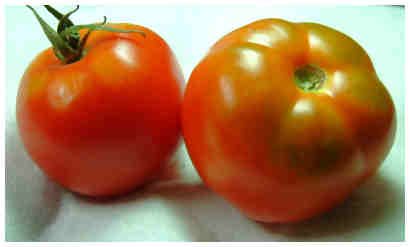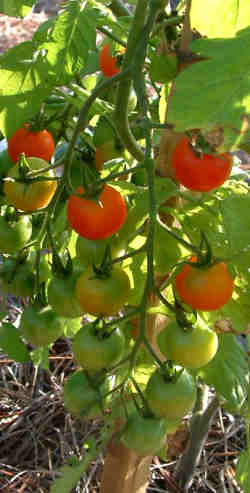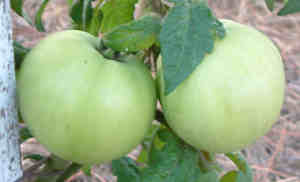Tomato Red Bush – Who Are You?
I have a tomato I am calling Red Bush, for lack of a better name. I bought a pack of White Bush seeds from a major seed-seller (Johnny’s). I planted some of the seeds, and got a surprise.
Red Bush – Who Are You?
 When it comes to tomato colors, red is dominant over white. So my red tomato has to be a cross from White Bush and an unknown red tomato. Yes, it’s a hybrid tomato – the result of two different parents.
When it comes to tomato colors, red is dominant over white. So my red tomato has to be a cross from White Bush and an unknown red tomato. Yes, it’s a hybrid tomato – the result of two different parents.
Now there’s no telling what variety the red plant was, especially since these seeds are from an old packet. But it’s an excellent chance to experiment! You see, when I save the seeds and plant them, I should get several different kinds of tomato plants, with different kinds of tomatoes. Some should be red, some white, some who knows what — depends on who the red parent was and if it was a hybrid!
(As an aside, I have another tomato plant growing from the same packet, and it is indeed the variety White Bush.)
Saving Tomato Seeds
Now I’m torn — do I eat that first red tomato off that plant, or do I save the seeds? The answer is – both! Since I have one ripe and one almost ripe, I can start the seed-saving process with some from the first tomato. Then some more from the second.
Since I’m saving these seeds for my own use, I’ll save them on a paper towel. But if I was saving tomato seeds to give to another person, I’d use the normal process that gets rid of any unwanted pathogens.
Having an obvious cross like this tomato makes it quite interesting to see what grows out. And while it’s fairly unusual to get an obviously crossed tomato in a commercial seed packet, it’s fun when you do!
Tomato Red Bush – who are you, really? I may never know, but I sure will have fun with its “children”!
Germinating Old Tomato Seeds, Reloaded
Have you ever found a pack of tomato seeds from a year or two ago and wondered if you could germinate those seeds and get them to grow? If you’ve ever had this happen, the answer is definitely try it!
Yesterday, I uncovered some seeds that I thought were lost to time. One was a tomato I had been breeding myself; another was a commercial packet that contained seeds that did not match the variety. It was from a highly respected seed firm, so the tomatoes were either 1) a mis-labeled pack or 2) crossed seeds. I’ve had crossed seeds before from a commercial pack, and it’s always exciting to see what might grow out.
How old are these seeds? They’ve been patiently waiting for 5 years!
How Long Do Tomato Seeds Last?
I’ve had this happen in the past, and I’ve successfully germinated seeds that I had for 10 years (see a previous post on seed germination) . So, I’m thinking that because the seeds were in a cool, low-humidity location, my 5-year-old seeds should germinate OK.
I don’t expect a 90% rate — probably more like 70 to 75%. But hey, I planted 8 seeds of each of the two packets, so even if I get just one or two good, sturdy plants from each, I will be thrilled. 🙂 (More is better, though, so I can select the healthiest plants to work with.)
Germinating Old Tomato Seeds
Because I want the seeds to have the best possible chance, I got together the following:
- 3-ounce paper cups
- Seed-starting soil
- Liquid kelp, diluted to 1/3 strength
- Windowsill greenhouse
- Seed germination heat pad
- Pair of scissors
- Plant labels
With the scissors, I cut slits in the bottom of the paper cups (for water drainage). I filled them to the top with the seed-starting soil and placed each cup in the windowsill greenhouse. When all the cups were filled, I took my liquid kelp mixture and soaked the soil, letting the water run out the bottom.
I let the cups stand for a few minutes, then lightly pushed the soil down. When I was satisfied that the top of the soil was moist, I put on the soil surface 4 seeds per cup. (Normally I’d only plant 2 per cup.)
I put a layer (maybe 3/8 inch thick) of the seed starting soil on top of the seeds and once again, lightly pressed down.
I added labels to the cups with the name of the tomato, and filled the windowsill greenhouse with enough water to come up 1/8 inch up the sides of the cups. That would provide enough water to make the seed-starting soil moist all the way through the cup, to the top.
Put the top on the greenhouse (to keep the humidity up) and set the whole kit and caboodle on the seed germination heating pad, which would gently warm the bottom of the greenhouse, and by extension, the soil and seeds.
How Long Will it Take?
Good question! Normally it takes anywhere from 3 to 10 days to germinate tomato seeds, with about 5 days being average. Given that these are older seeds, I don’t expect to see signs of germination for 5 days at the earliest, 7 days on average. Therefore, I wait impatiently. 😉
SuperSweet 100 Cherry Tomatoes
SuperSweet 100 cherry tomatoes are fun to grow. And what’s really nice is that the cherry tomatoes they produce are nice and true to their name – sweet!
A Little About SuperSweet 100
This particular tomato is an improved variety over Sweet 100. And supposedly a relative of Sweet Million. It’s a hybrid tomato, so plants grown from the seeds won’t necessarily breed true. Although I do believe I will try it anyway! I’m curious to see what I’ll get next season.
The SuperSweet 100 plant in the photo (and you can click the photo for a larger picture) has the cherry tomatoes just starting to turn red. It will be interesting to look at when more of the fruits start ripening.
This particular plant is a survivor! It’s made it through nights in the 30’s, being nibbled on by rabbits and being blown down in high winds. It’s also not growing in the best part of the garden, so it’s got a lot going against it. But it doesn’t seem to matter; it keeps putting out flowers, and nearly every blossom sets fruit.
SuperSweet 100 is an indeterminate plant with regular leaves.
Growing Cherry Tomatoes
One nice thing about the SuperSweet 100 is that it’s a cherry tomato of a perfect size for your mouth, at about 3/4″ to about 1″ in size. I have mine growing in the ground, but I think they’d grow fine in a large container on the patio. For a true bounty, I’d use a 10-gallon container.
You will need to stake this plant. Mine is on a 5.5′ stake, which would probably also be OK for a container. If it was in the good part of the garden, I’d rather use a 7′ stake.
SuperSweet 100 is a fantastic “garden candy” — great for popping in your mouth while working in the garden. Actually, so far this season, none of the ripe fruits have made it to the table — I’ve munched them while out in the yard. Soon enough, though, there will be plenty to eat outside and bring into the house for salads.
Great Tomato Experiment, Revisited
I’ve had a bit of a setback on The Great Tomato Experiment; I ran into a stretch of bad weather, followed by what I think was possibly an overdose of potassium. As a result, all three plants are in sad, sad shape. In fact, so sad that I am starting over!
What Will I Do Differently?
First, is that I have come across some nice 17-gallon containers, and I’ll use them instead of the 10-gallons I had been using. I’ll sterilize and re-use the 10-gallons for some other tomatoes I have coming up for the summer (including two mystery tomatoes).
I’m going to add sphagnum peat moss and perlite to each of the containers. I’ve found the original mixture I used compacted a bit too much for my liking.
I’m going to add the main dose of fertilizer to the soil before planting, then mix it in well. I found with my raised bed tomatoes that when I did this, the plants grew more vigorously compared to the ones where I added the fertilizer as a side-dressing in the beginning.
Finally, I am using a different tomato variety. For some reason, Pineapple doesn’t seem to like my growing conditions (I have a 4th plant that I am growing in the ground in another part of the garden). It’s growing fairly well and putting forth tomatoes, but it’s not as vigorous as I would hope.
And the New Tomato Variety Is…
I have chosen Big Raspberry as the new tomato variety for The Great Tomato Experiment for the following reasons:
- Big Raspberry is a potato-leafed plant, and I find that tomato plants with potato leaves generally fare better in my garden.
- The tomatoes don’t generally get large (maybe 9 ounces), so if I can get a tomato of this variety over 1 lb using the giant tomato techniques, it will be an accomplishment.
- The plant is productive, but not necessarily tall. So if I can get the plant over 6 feet using the world record tomato techniques, it will be a visible accomplishment. Especially since I am growing it in a container!
- Finally, I’m choosing Big Raspberry because it’s an earlier tomato compared to Pineapple. Since it’s already April, I need to play catch-up before the worst of the South Florida summer heat arrives.
If you’re still wanting to experiment along with me and can’t locate Big Raspberry, a good second choice might be Prudens Purple. In fact, I would have used Pruden’s Purple as my first choice for this test if I hadn’t already had some growing in the garden. My other choice would be Caspian Pink.
So, I planted my seeds today. I planted 5 so I could choose the best 3 for the experiement. The other two…well, I’m sure I can find someone in my neighborhood who might like a couple of plants!
So, while the first part of the experiment failed, I still have an opportunity to continue. Onward!
Hybrid Tomatoes, Part 2
I talked about hybrid tomatoes in part 1 of this post. Now that we’ve discussed the cherry varieties, let’s talk about how the slicer-size hybrids are doing in the garden.
Hybrid Tomatoes in the Garden
Just as a review, I have the following slicer-sized hybrid tomato plants in the garden:
- Celebrity Bush (determinate slicer)
- Fabulous (determinate slicer)
- Goliath Bush (determinate slicer)
- Park’s Whopper (indeterminate slicer)
All these plants have there own merits, but so far, Fabulous has been, well, fabulous! It’s by far the most vigorous, and has a nice, healthy growth, and regular leaves. I have it growing in a 5-gallon container, and it behaves as if it were in the ground – very lush and full of blossoms.
There aren’t any ripe tomatoes yet on Fabulous (darn!), but I’m looking forward to them. If they taste even half as good as the plant currently looks, it’s earned a continued spot in my garden.
And how have the others fared?
Bush Goliath has been the most prolific to date, and the tomatoes from one of the plants has been fairly good; the other one’s taste has been forgettable. Both plants currently have ripening tomatoes, so we’ll see how this batch does. Bush Goliath is a fairly small plant in my garden, at just 16 inches tall, with rugose leaves.
Celebrity Bush has had a hard time with the cold weather this year. While it’s normally quite productive, this season’s chillier-than-usual winter has taken its toll. It has come back some, now that the warm weather is here to stay. I’ll keep an eye on it. This plant is about 12 inches tall at the moment, and has rugose leaves.
Park’s Whopper currently has the best tasting fruit of the group. The winter has been hard on it as well, but it’s coming back and producing some nice tomatoes. Had a great one on a sandwich yesterday! The plant is now at 12 inches tall (the February frost nearly did the plant in totally), and has regular leaves.

